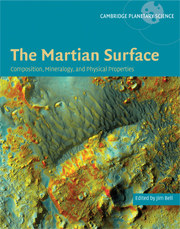Book contents
- Frontmatter
- Contents
- List of contributors
- Foreword
- Acknowledgments
- Part I Introduction and historical perspective
- Part II Elemental Composition: Orbital and in situ Surface Measurements
- Part III Mineralogy and Remote Sensing of Rocks, Soil, Dust, and Ices
- 7 Mineralogy of the Martian surface from Mars Express OMEGA observations
- 8 Visible to near-IR multispectral orbital observations of Mars
- 9 Global mineralogy mapped from the Mars Global Surveyor Thermal Emission Spectrometer
- 10 The compositional diversity and physical properties mapped from the Mars Odyssey Thermal Emission Imaging System
- 11 Mars' crustal magnetization: a window into the past
- 12 Multispectral imaging from Mars Pathfinder
- 13 Mars Exploration Rover Pancam multispectral imaging of rocks, soils, and dust at Gusev crater and Meridiani Planum
- 14 The mineralogy of Gusev crater and Meridiani Planum derived from the Miniature Thermal Emission Spectrometers on the Spirit and Opportunity rovers
- 15 Iron mineralogy and aqueous alteration on Mars from the MER Mössbauer spectrometers
- 16 Magnetic properties of Martian surface materials
- 17 Martian meteorites as crustal samples
- Part IV Physical Properties of Surface Materials
- Part V Synthesis
- Part VI Summary, Upcoming Missions, and New Measurement Needs
- Index
- Plate section
- References
16 - Magnetic properties of Martian surface materials
from Part III - Mineralogy and Remote Sensing of Rocks, Soil, Dust, and Ices
Published online by Cambridge University Press: 10 December 2009
- Frontmatter
- Contents
- List of contributors
- Foreword
- Acknowledgments
- Part I Introduction and historical perspective
- Part II Elemental Composition: Orbital and in situ Surface Measurements
- Part III Mineralogy and Remote Sensing of Rocks, Soil, Dust, and Ices
- 7 Mineralogy of the Martian surface from Mars Express OMEGA observations
- 8 Visible to near-IR multispectral orbital observations of Mars
- 9 Global mineralogy mapped from the Mars Global Surveyor Thermal Emission Spectrometer
- 10 The compositional diversity and physical properties mapped from the Mars Odyssey Thermal Emission Imaging System
- 11 Mars' crustal magnetization: a window into the past
- 12 Multispectral imaging from Mars Pathfinder
- 13 Mars Exploration Rover Pancam multispectral imaging of rocks, soils, and dust at Gusev crater and Meridiani Planum
- 14 The mineralogy of Gusev crater and Meridiani Planum derived from the Miniature Thermal Emission Spectrometers on the Spirit and Opportunity rovers
- 15 Iron mineralogy and aqueous alteration on Mars from the MER Mössbauer spectrometers
- 16 Magnetic properties of Martian surface materials
- 17 Martian meteorites as crustal samples
- Part IV Physical Properties of Surface Materials
- Part V Synthesis
- Part VI Summary, Upcoming Missions, and New Measurement Needs
- Index
- Plate section
- References
Summary
ABSTRACT
The surface and aeolian dust on Mars is rich in iron compounds, and significant quantities of dust have been observed to stick to permanent magnets that are either exposed to the dusty atmosphere, exposed to dust released by grinding into rocks, or inserted into the soil. All successful lander missions to Mars so far have carried permanent magnets of various designs for the purpose of studying dust magnetic properties. The magnetism of the aeolian dust is the result of the presence of magnetite, which apparently derives from mechanical weathering of magnetite-rich surface rocks. A strong correlation between the elements titanium and iron is observed in elemental abundance spectra of dust attracted to permanent-magnet surfaces, suggesting that the magnetite responsible for the magnetization of the dust is actually titanomagnetite. Overall, the dust can be shown to have a saturation magnetization of less than 2 A m2 kg− 1. However, some grains are significantly more magnetic, and by interaction with a permanent magnet it is possible to separate the airborne dust into populations of more and less magnetic grains. Subpopulations attracted to a magnet have been seen to have magnetizations above 7 A m2 kg− 1. The widespread presence of magnetite and other easily oxidized minerals like olivine in rocks and in the global Martian dust imply that the Martian surface has been largely devoid of liquid water for a very long time.
- Type
- Chapter
- Information
- The Martian SurfaceComposition, Mineralogy and Physical Properties, pp. 366 - 380Publisher: Cambridge University PressPrint publication year: 2008
References
- 6
- Cited by

